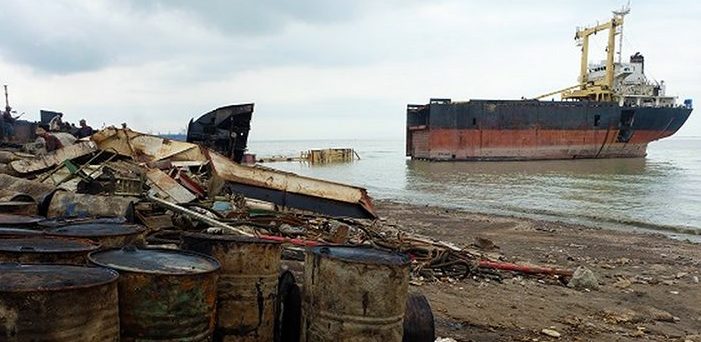The Future of Ship Recycling Industries: A Greener Horizon on the Seas

As the world shifts its focus towards sustainability and environmental consciousness, the ship recycling industry has found itself at a crossroads. Often referred to as the “graveyard” of the maritime industry, ship recycling has traditionally been an essential yet under-regulated sector. Ships, after a lifespan of 20 to 30 years, are taken apart for scrap metal and other materials, a process that, if not managed properly, can lead to significant environmental harm and hazardous working conditions. However, the future of this industry is rapidly evolving as regulations tighten, and companies and nations alike strive for greener, more efficient methods of decommissioning ships.
The Current State of Ship Recycling
Ship recycling has long been a critical part of the maritime economy. It provides raw materials like steel, which is reused in various industries, especially in construction. A large percentage of the steel produced in the world today comes from recycled ships. Despite its importance, shipbreaking is often criticized for the environmental pollution it causes and the unsafe working conditions in some regions.
Most of the world’s ship recycling takes place in South Asia, particularly in Bangladesh, India, and Pakistan. These countries have become global leaders in the industry due to their lower labour costs and less stringent environmental regulations. However, the downside is that these countries also face significant challenges related to worker safety and pollution.
Shipbreaking yards in these regions often operate in what is known as the “beaching” method. In this practice, ships are driven onto shorelines, where workers dismantle them manually. The process is labour-intensive, and workers frequently deal with hazardous materials such as asbestos, heavy metals, and oils. The lack of proper safety gear and training has led to numerous injuries and fatalities over the years. Additionally, the contamination of nearby waters and soil has had a lasting impact on local ecosystems.
Despite these challenges, ship recycling remains an essential part of the global supply chain. The industry offers an environmentally friendly way to dispose of ships, reducing the need for raw material extraction and contributing to the circular economy. However, the future of the industry hinges on addressing its most pressing issues: safety, environmental sustainability, and efficiency.
Evolving Regulations: A Push for Sustainability
In recent years, there has been a growing awareness of the need to reform the ship recycling industry. Environmental organizations, international bodies, and governments are increasingly calling for stricter regulations to ensure that ships are dismantled in a manner that is safe for both workers and the environment.
The most significant development in this regard is the Hong Kong International Convention for the Safe and Environmentally Sound Recycling of Ships, adopted in 2009. The convention sets global standards for ship recycling, requiring shipyards to establish safe and environmentally sound practices. Ships are also required to carry an Inventory of Hazardous Materials (IHM), detailing the substances onboard that could pose a risk during dismantling.
However, the implementation of the Hong Kong Convention has faced challenges. For it to enter into force, it requires ratification by a sufficient number of countries, representing a specific percentage of the world’s merchant shipping tonnage. While progress has been made, it has been slow, with some of the largest ship recycling countries hesitant to fully commit.
The European Union Ship Recycling Regulation is another key piece of legislation shaping the future of the industry. Enforced since 2018, it requires that ships flying the flag of an EU member state can only be recycled in approved facilities that meet stringent environmental and safety standards. The regulation also bans the beaching method, pushing for recycling in more controlled environments like dry docks.
While these regulations are significant steps forward, they also present challenges. Compliance can be expensive, and many shipowners opt to flag their vessels in countries with less stringent regulations to avoid the costs associated with safer and more environmentally friendly recycling practices. This phenomenon, known as “flagging out,” is a loophole that undermines the effectiveness of global regulations.
Green Technology and Innovation: The Future is Sustainable
As regulatory pressures mount, the industry is looking toward technological innovation to address its challenges. Green technology is set to play a crucial role in the future of ship recycling, making the process safer, more efficient, and less harmful to the environment.
One of the most promising developments is the use of automated systems for ship dismantling. Automation can significantly reduce the risks posed to human workers by performing tasks that are dangerous or involve hazardous materials. Robots and advanced machinery can cut apart ships with greater precision, minimizing the release of harmful substances into the environment and improving the overall efficiency of the process.
Another important innovation is the development of cleaner methods for handling and disposing of hazardous materials. For example, new technologies are being explored to safely remove asbestos, lead, and other harmful substances from ships before they are dismantled. These methods are not only safer for workers but also reduce the environmental impact of the recycling process.
Some shipyards are also adopting zero-waste recycling methods, which aim to recycle or repurpose every part of the ship. This includes everything from the steel used in the hull to smaller components like wiring and insulation. By maximizing the reuse of materials, shipyards can minimize the waste that ends up in landfills and reduce the need for new raw materials.
Additionally, advances in green ship design are helping to shape the future of recycling. As more shipbuilders adopt eco-friendly principles, new ships are being designed with recycling in mind. This includes using materials that are easier to recycle and reducing the use of hazardous substances in the construction of the ship. These efforts will not only make ship recycling safer and more sustainable but will also lower the cost of the process in the long run.
Regional Shifts: A More Global Approach
The global nature of the maritime industry means that ship recycling is a truly international concern. While South Asia has long been the dominant player in shipbreaking, other regions are emerging as important hubs for sustainable ship recycling.
Countries in Europe, the Middle East, and East Asia are investing in modern, high-tech ship recycling facilities that meet international environmental and safety standards. These facilities often employ advanced techniques such as dry dock dismantling, which allows for greater control over the recycling process and minimizes environmental harm.
In Turkey, for example, ship recycling yards in Aliaga are gaining recognition for their adherence to environmental and safety regulations. These facilities use advanced technology and follow stricter guidelines, making them an attractive option for shipowners looking to recycle their vessels more responsibly.
Similarly, China has been making strides in modernizing its ship recycling industry. With government support, Chinese shipyards are adopting greener practices and investing in the technology needed to meet international standards. As China continues to play a leading role in the global shipping industry, its efforts to improve ship recycling could have a significant impact on the future of the sector.
Economic Considerations: Balancing Costs and Benefits
One of the major challenges facing the future of ship recycling is the balance between economic viability and environmental sustainability. While green technology and stricter regulations are essential for the long-term health of the industry, they also come with higher costs. For many shipowners, the decision of where and how to recycle a ship is driven by economics. Recycling in facilities that meet international standards can be significantly more expensive than using less-regulated yards in countries with lower labor costs.
To address this, some have called for the introduction of incentives to encourage shipowners to choose greener recycling options. This could include subsidies for recycling in approved facilities or financial penalties for using substandard yards. Additionally, shipowners who prioritize sustainability in their recycling practices could benefit from improved public perception and stronger relationships with environmentally conscious stakeholders.
The rise of corporate social responsibility (CSR) is also playing a role in shaping the future of ship recycling. Many companies, particularly in Europe and North America, are under increasing pressure from investors and customers to adopt environmentally friendly practices. As a result, shipowners are more likely to consider the environmental impact of their recycling decisions, even if it means higher costs.
Conclusion: Navigating Toward a Sustainable Future
The future of the ship recycling industry is being shaped by a complex interplay of environmental, economic, and regulatory factors. As the world moves toward a greener future, the industry is under pressure to adopt more sustainable practices, improve safety for workers, and minimize its environmental impact.
Technological innovation, evolving regulations, and regional shifts are all playing a role in transforming the industry. While challenges remain, the ship recycling industry is poised to become a key player in the global effort to create a more sustainable economy.
With continued investment in green technology, stronger international cooperation, and a growing focus on corporate responsibility, the ship recycling industry can navigate toward a future where sustainability and economic viability go hand in hand. The journey may be long and complex, but the destination is clear: a cleaner, safer, and more sustainable ship recycling industry that benefits both people and the planet.
Author: shipping inbox
shipping and maritime related web portal








